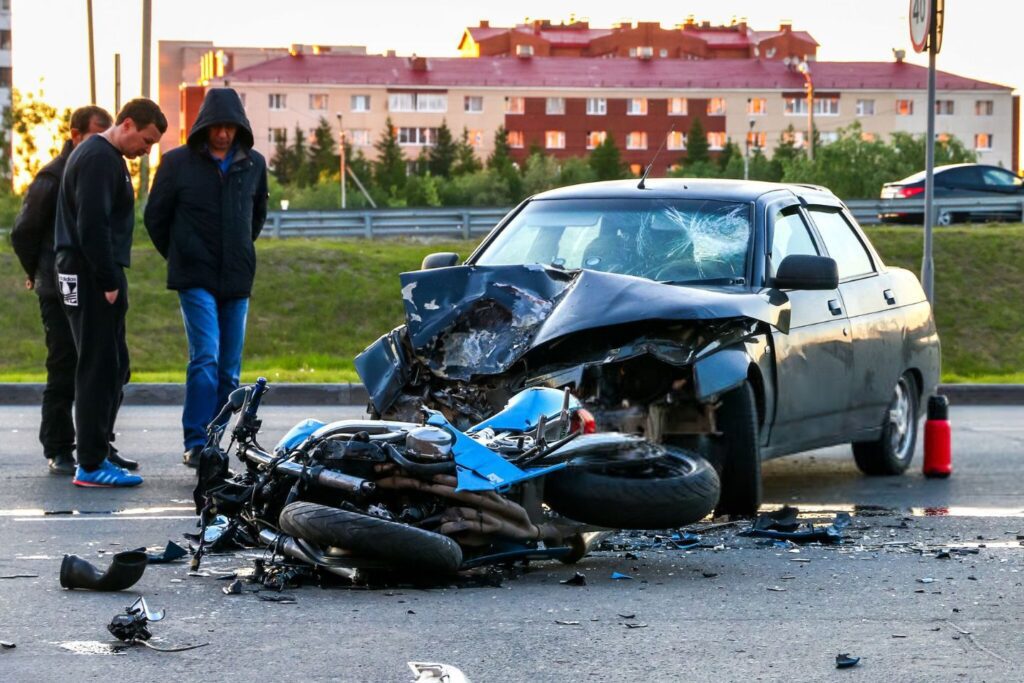Navigating the roads of Lancaster, California, comes with its unique set of challenges, especially for motorcyclists. The stark figures paint a vivid picture: motorcyclists represented 14% of all traffic fatalities in 2020, a disproportionate statistic considering they make up less than 3% of registered vehicles. In Lancaster alone, 41 individuals were injured or killed in motorcycle crashes that year. These numbers aren’t just statistics; they’re a wake-up call for every rider and driver in a city home to over 176,000 people.
This article explores motorcycle accidents in Lancaster CA, covering both their causes and the legal steps that follow. We aim to give readers a clear understanding of how these accidents happen and what to do next, helping prevent future incidents and manage the consequences if they happen.
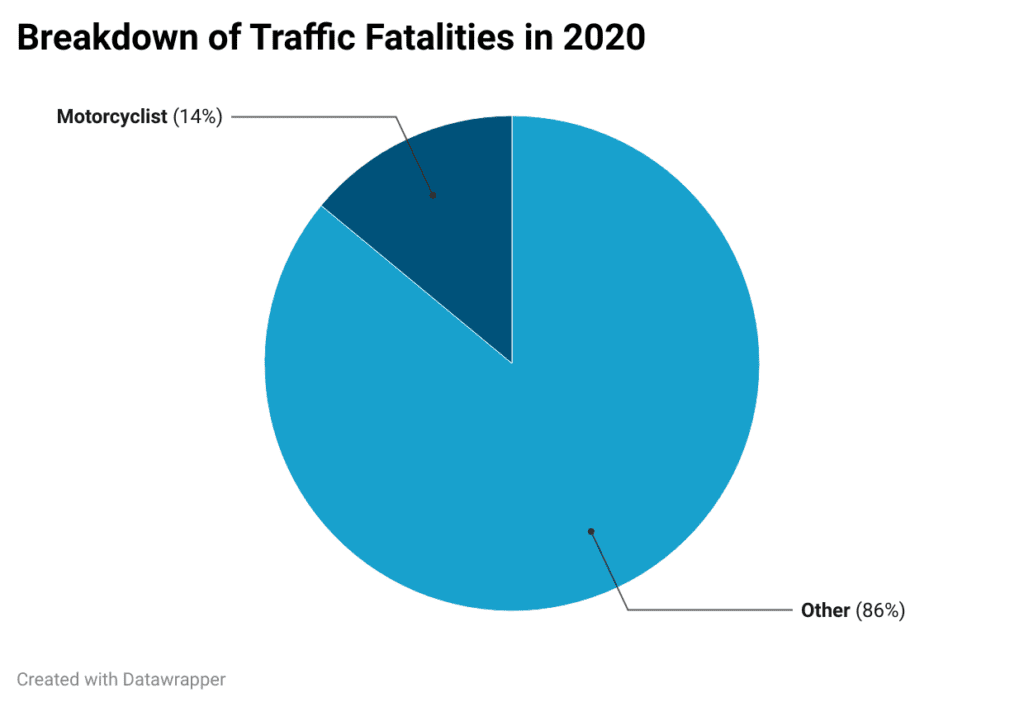

Common Causes of Motorcycle Accidents in Lancaster CA
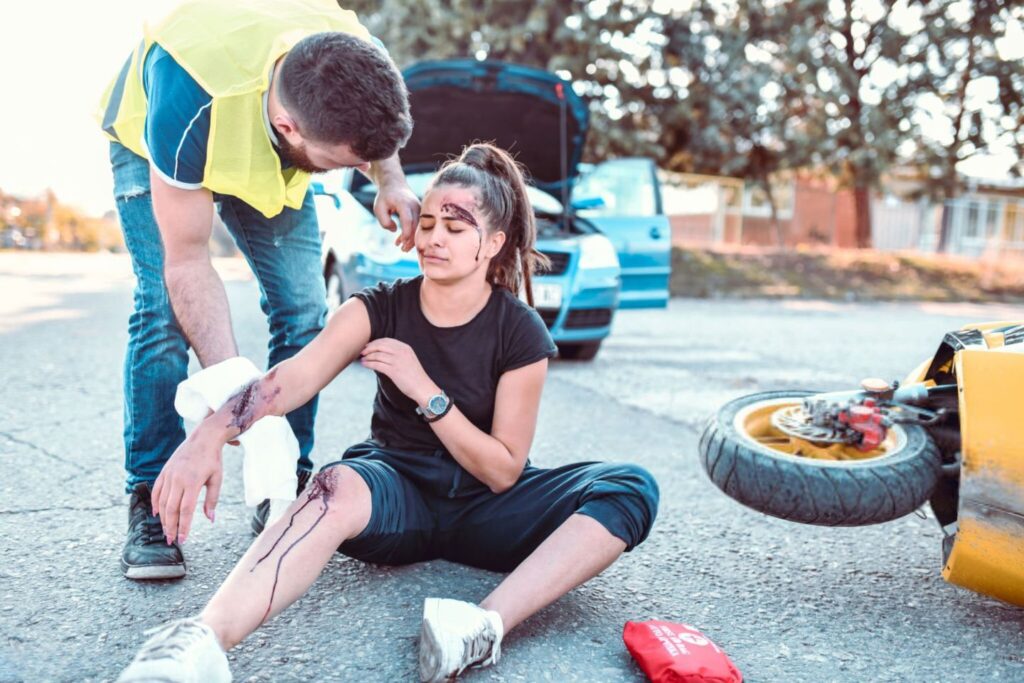

Motorcycle accidents stem from a variety of factors. The National Highway Traffic and Safety Administration’s 2021 report sheds light on these critical aspects, backed by compelling statistics:
- Speeding: Thirty-three percent of all motorcycle riders involved in fatal crashes in 2021 were speeding. This is significantly higher compared to 22 percent for passenger car drivers, indicating a greater prevalence of speeding among motorcyclists.
- Alcohol Impairment: Among the 5,636 motorcyclists killed in traffic crashes in 2021, 1,624 (29%) were alcohol-impaired. This statistic underscores the significant impact of drinking and riding.
- Helmet Use: Helmets are estimated to be 37 percent effective in preventing fatalities for motorcycle riders and 41 percent for passengers. However, in California in 2021, the percentage of motorcyclists killed who were not helmeted was relatively low at 7%, highlighting the state’s adherence to helmet use.
- Collisions with Motor Vehicles: Fifty-seven percent of the motorcycles involved in fatal crashes were in collisions with motor vehicles in transport, emphasizing the danger posed by interactions between motorcycles and other vehicles on the road.
- Lane Splitting: The practice of lane splitting, where a motorcycle rides between lanes of stopped or slowly moving cars, often leads to accidents due to the close proximity to other vehicles and the reduced space to maneuver.
- Inexperienced Riders: Thirty-six percent of motorcycle riders involved in fatal crashes in 2021 were riding without valid motorcycle licenses at the time of the crashes, highlighting the dangers associated with inexperienced riders.
- Road Hazards: Lancaster’s desert landscape means motorcyclists often face unique road hazards such as sand drifts on the pavement and tumbleweeds, especially during windy conditions. Potholes and uneven road surfaces on lesser-maintained roads outside urban areas also pose significant risks.
- Poor Visibility: In Lancaster, dust storms can suddenly reduce visibility, creating dangerous riding conditions for motorcyclists. Early morning and late evening rides also face challenges with low light conditions in rural areas, where street lighting is minimal.
Struggling after a personal injury after a motorcycle accident in Lancaster CA? Let the Personal Injury Center be your guide. Our team of professionals is dedicated to connecting you with the expert legal help you need. Contact us today to start your journey towards the compensation you deserve.
Steps to Take after a Motorcycle Accident in Lancaster, CA
If you’re involved in a motorcycle accident in Lancaster, CA, knowing the right steps to take can significantly impact your safety and the outcome of any future claims or legal actions.
Here’s a guide on what to do:
- Ensure Safety: If possible, move to a safe area away from traffic. Shut off your motorcycle to avoid any fire hazards. Check for injuries on yourself and others.
- Call 911: Reporting the accident is crucial, especially if there are injuries or significant damage. Police will create an essential report for legal and insurance purposes.
- Exchange Info: Swap contact and insurance details with all involved parties—names, addresses, phone numbers, and insurance policy numbers are key.
- Document the Scene: Take photos of the accident site, damages, injuries, and any relevant road signs. This evidence is vital for claims and legal matters.
- Seek Medical Attention: Some injuries are not immediately noticeable. Visit a doctor or ER to ensure no hidden injuries and to document your condition.
- Inform Your Insurance: Notify your insurer promptly without admitting fault. A factual account aids the claims process.
- Consult an Attorney: For significant injuries or legal complications, get advice from a motorcycle accident lawyer. They can navigate complex issues and advocate for you.
Don’t face the aftermath of an accident alone. The Personal Injury Center is here to empower you with knowledge and connect you with top legal talent in your area. Discover your rights and explore your options with us. Your first step to justice begins here
Legal Requirements for Motorcyclists in Lancaster, CA
Navigating the roads on two wheels in Lancaster, CA, means abiding by specific legal standards aimed at safeguarding you and your fellow road users.
Here’s what you need to know about the laws governing motorcycle riding in the state:
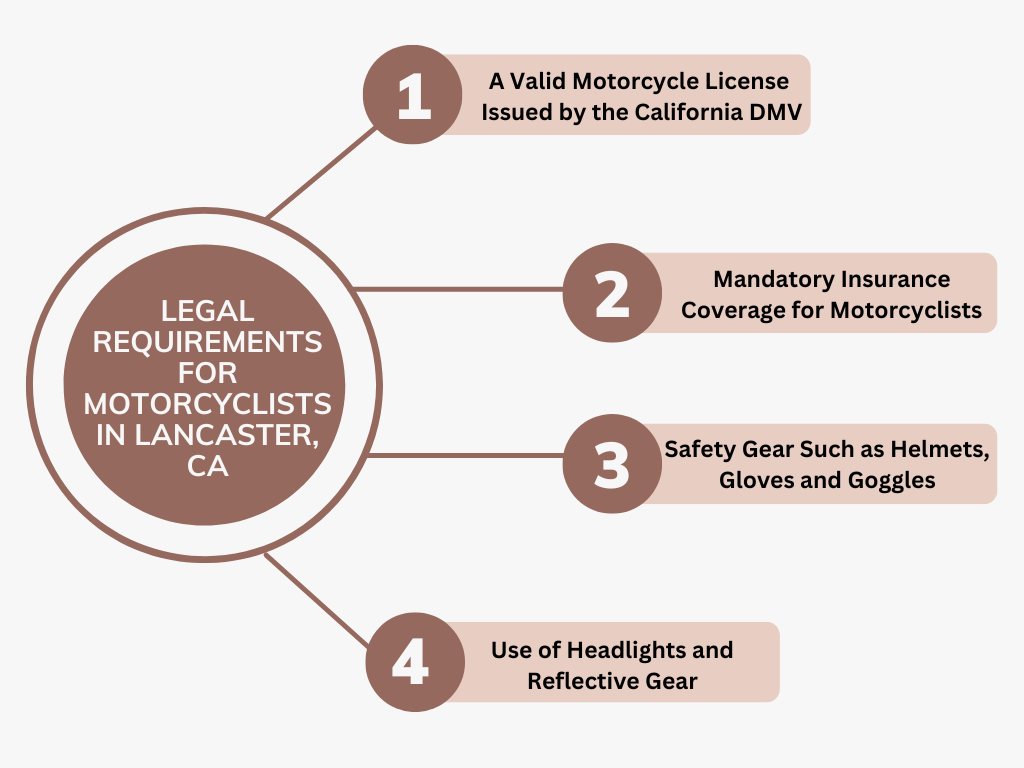

California’s Motorcycle Licensing Requirements
California Vehicle Code (CVC) § 12804.9 and 12500 specify the licensing requirements for motorcycle riders. To legally operate a motorcycle, riders must hold a valid Class M1 or M2 motorcycle license issued by the California Department of Motor Vehicles (DMV).
Obtaining this license involves passing a knowledge test, a skills test, and/or completing a California Highway Patrol (CHP) approved motorcycle safety course, which can exempt the applicant from the DMV’s skills test. This process ensures riders are well-prepared to tackle the road safely.
Mandatory Insurance Coverage for Motorcyclists
Under California Vehicle Code (CVC) § 16020, every person driving on the road, including those on motorcycles, must have proof they can cover the costs if they’re responsible for an accident. This is usually done through liability insurance, which is a type of insurance that pays for any damage or injuries you cause to others in an accident. The law sets the minimum amount of this insurance you must have:
- $15,000 for injury or death to one person: If you’re at fault in an accident that injures someone or worse, your insurance should be able to cover up to $15,000 for each person hurt or killed.
- $30,000 for injury or death per accident: If several people are hurt in the same accident, your insurance must cover up to $30,000 in total to help with their medical bills or other costs.
- $5,000 for property damage: This covers damage to someone else’s property, like their car, fence, or bike, up to $5,000.
This requirement makes sure that if you’re in an accident and it’s your fault, you have a way to help cover the costs of the other person’s injuries or property damage.
Helmet Laws and Safety Gear Regulations
The California Vehicle Code § 27803 mandates that all motorcycle riders and their passengers wear U.S. Department of Transportation (DOT) approved helmets. This law is enforced to reduce the risk of head injuries, which are common and often severe in motorcycle accidents. While the state law specifically requires helmet use, it also recommends, though does not mandate, additional protective gear such as gloves, long pants, and eye protection for enhanced safety.
For more information on how to choose the right motorcycle helmet, watch this video.
Use of Headlights and Reflective Gear
To enhance visibility, California law requires motorcycles to have their headlights on at all times, even during daylight (California Vehicle Code § 25650.5). Additionally, while not legally required, wearing reflective or brightly colored gear is highly recommended to make yourself more visible to other drivers, particularly during dawn, dusk, and night.
Seeking Compensation After a Motorcycle Accident in Lancaster CA
Following a motorcycle accident in California, securing the compensation you’re entitled to can seem like navigating a complex maze. This detailed guide aims to simplify that process, ensuring you’re well-equipped to move forward confidently.
Understand Your Coverage
Begin by thoroughly understanding your insurance policy. California’s mandatory minimum liability insurance is $15,000 for bodily injury per person, $30,000 per accident, and $5,000 for property damage, as discussed previously.
These requirements are outlined in the California Insurance Code §11580.1b. But your policy might give you more protection than just these basics. You might also have:
- Collision coverage: Pays for repairs to your motorcycle if it’s damaged in a crash.
- Comprehensive coverage: This covers other types of damage to your bike not caused by a collision, like theft, fire, or vandalism.
- Uninsured/Underinsured Motorist coverage: If you’re hit by someone who doesn’t have insurance or doesn’t have enough to cover the damage they’ve caused, this coverage can help make up the difference.
California Fault Laws
California follows a rule called “pure comparative negligence,” which is a fancy way of saying that if you’re partly to blame for the accident, you can still get some money for your injuries or damages. However, there’s a catch—the amount you receive will be less, depending on how much of the accident was your fault.
Here’s how it works:
- If the accident was 25% your fault, and you were originally going to get $100,000, you’d now receive $75,000. That’s because 25% (your share of the blame) is taken out of the total compensation.
- On the other hand, if you were 75% at fault, you’d only get $25,000.
This rule is outlined in the California Civil Code §1714. Understanding this can help you set realistic expectations for what compensation you might receive after an accident.
Filing a Claim
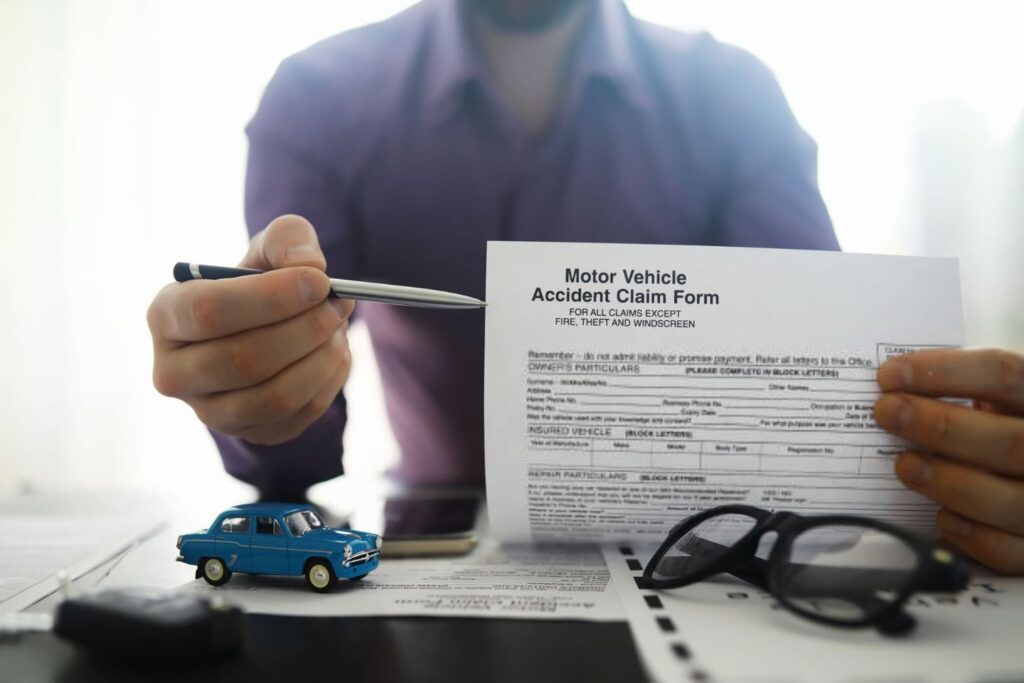

Filing a claim means officially asking an insurance company to compensate you for your losses after an accident. This could be for damage to your motorcycle, medical bills due to injuries, or even money you couldn’t earn because you were recovering. When it’s time to do this, especially if you’re asking the insurance company of the person who caused the accident to pay up, having strong, detailed proof is crucial.
Here’s what you need:
- The official accident report: This is the formal record made by the police, detailing what happened and who was involved.
- Detailed medical records: These show the injuries you sustained, the treatment you received, and how much it all cost.
- Photographic evidence from the scene: Photos can prove the extent of damage and help illustrate how the accident happened.
- Documentation of lost wages: If you had to miss work because of the accident, these documents show how much money you lost as a result.
California Insurance Code §790.03(h) demands that insurance companies treat your claim fairly and make a decision quickly. This law is on your side, ensuring that if you’ve put together your claim thoroughly, the insurance company needs to assess it honestly and without unnecessary delay.
Damages You Can Claim
In legal terms, “damages” refer to the money awarded to someone as compensation for loss or injury. This compensation aims to help you financially recover to the state you were in before the accident happened. Here’s a closer look at the types of damages you can claim:
- Medical Expenses: This isn’t just about the hospital bills you’ve already received; it also includes the cost of any medical care you might need in the future because of your injuries. This can cover everything from emergency room visits to follow-up appointments, physical therapy, and any ongoing treatments.
- Property Damage: If your motorcycle was damaged or destroyed in the accident, you could receive money to repair or replace it. This category also covers any personal items that were damaged during the incident, such as your helmet, clothing, or even a phone that was in your jacket pocket.
- Lost Wages: If you had to miss work because of the accident, you could be compensated for the money you would have earned during that time. This includes not only your missed salaries but also lost opportunities for overtime, bonuses, and other forms of income.
- Pain and Suffering: This type of compensation is a bit more abstract because it’s about the physical pain and emotional stress you endure as a result of the accident. While harder to put a price on, it recognizes that the impact of an accident isn’t just financial but also personal, affecting your quality of life and overall well-being.
Need expert legal advice after a motorcycle accident in Lancaster, California? The Personal Injury Center is your go-to source for understanding your legal rights and finding the best lawyer for your case. We’re committed to helping you get the compensation you’re entitled to. Reach out now for the support you need.
Key Takeaways
|
Frequently Asked Questions
Can I sue after a motorcycle accident?
Yes, you can sue after a motorcycle accident if you believe another party’s negligence caused your injuries. In California, as per the statute of limitations, you have two years from the date of the accident to file a personal injury lawsuit.
Can a motorcycle accident cause PTSD?
Absolutely. A motorcycle accident can be a traumatic event, leading to Post-Traumatic Stress Disorder (PTSD) among survivors. Symptoms can include recurring flashbacks, severe anxiety, and uncontrollable thoughts about the accident.
How long does it take to heal from a motorcycle accident?
The recovery period after a motorcycle accident is greatly influenced by the extent of the injuries sustained. Injuries of a minor nature could be resolved in a matter of weeks, whereas severe injuries, such as broken bones or internal damage, might require several months to several years for complete healing. Achieving a full recovery frequently hinges on receiving prompt medical care and undergoing proper rehabilitation.



